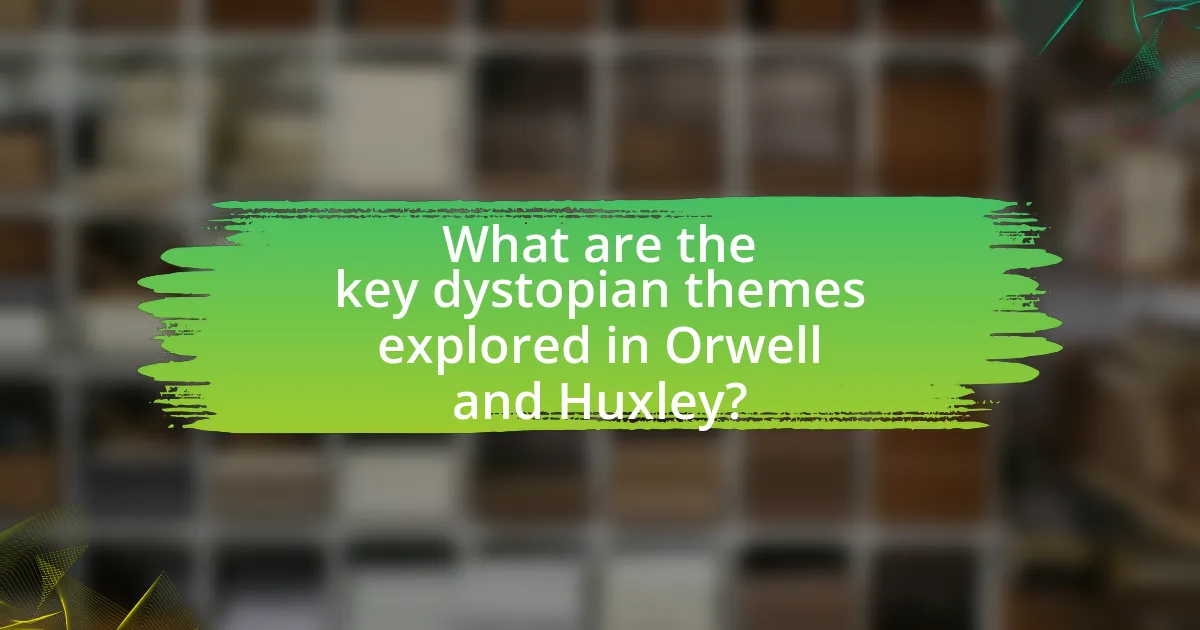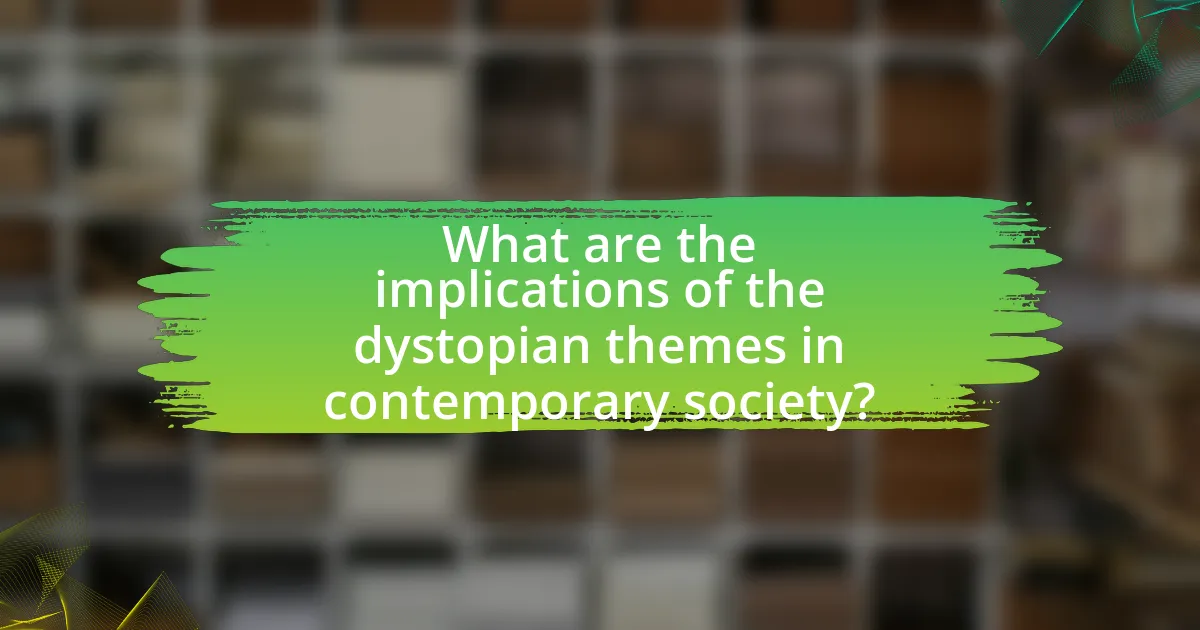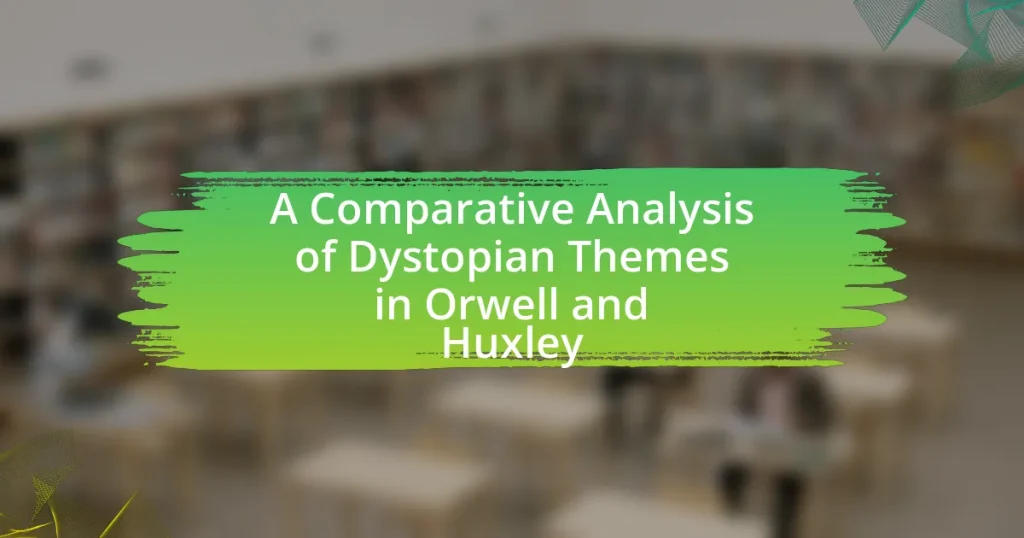The article provides a comparative analysis of dystopian themes in George Orwell’s “1984” and Aldous Huxley’s “Brave New World,” focusing on key concepts such as totalitarianism, surveillance, and the loss of individuality. It examines the differing methods of control employed by both authors, with Orwell emphasizing fear and repression while Huxley critiques hedonism and complacency. The article also explores the societal issues addressed in their works, the influence of the authors’ backgrounds on their narratives, and the literary techniques used to convey their themes. Additionally, it discusses the implications of these dystopian themes in contemporary society and offers practical steps individuals can take to resist emerging dystopian trends.

What are the key dystopian themes explored in Orwell and Huxley?
The key dystopian themes explored in George Orwell’s “1984” and Aldous Huxley’s “Brave New World” include totalitarianism, surveillance, and the loss of individuality. In “1984,” Orwell presents a society under constant surveillance by a totalitarian regime, where the government manipulates truth and suppresses dissent, exemplified by the slogan “Big Brother is watching you.” Conversely, Huxley’s “Brave New World” depicts a society that prioritizes pleasure and conformity over individuality, using technology and conditioning to maintain social order, as seen in the use of the drug soma to suppress discontent. Both authors illustrate the dangers of oppressive governments, but while Orwell emphasizes fear and repression, Huxley focuses on the consequences of hedonism and complacency.
How do Orwell’s and Huxley’s visions of dystopia differ?
Orwell’s and Huxley’s visions of dystopia differ primarily in their methods of control and the nature of oppression. Orwell’s “1984” depicts a totalitarian regime that employs surveillance, censorship, and brute force to maintain power, exemplified by the omnipresent telescreens and the Thought Police. In contrast, Huxley’s “Brave New World” presents a society that uses pleasure, consumerism, and psychological manipulation to achieve compliance, as seen through the use of soma and the conditioning of citizens from birth. This fundamental difference highlights Orwell’s focus on fear and repression versus Huxley’s emphasis on distraction and hedonism as means of societal control.
What societal issues do Orwell and Huxley address in their works?
Orwell and Huxley address the societal issues of totalitarianism, surveillance, and the loss of individuality in their works. In “1984,” Orwell illustrates the dangers of oppressive government control through constant surveillance and propaganda, exemplified by the Thought Police and the manipulation of truth. Huxley’s “Brave New World” critiques a society that sacrifices individuality for technological advancement and consumerism, showcasing the consequences of a hedonistic culture that prioritizes pleasure over freedom. Both authors highlight the risks of dehumanization and the erosion of personal autonomy in the face of powerful societal forces.
How do the authors’ backgrounds influence their dystopian narratives?
The authors’ backgrounds significantly influence their dystopian narratives by shaping their perspectives on society, politics, and human nature. George Orwell, having experienced the Spanish Civil War and the rise of totalitarian regimes, infused his works with a critical view of oppressive governments, as seen in “1984,” where he illustrates the dangers of surveillance and authoritarianism. Aldous Huxley, influenced by his family’s intellectual background and his experiences with the World Wars, presented a more nuanced view of dystopia in “Brave New World,” focusing on the perils of consumerism and technological control. These distinct backgrounds lead to contrasting themes: Orwell warns against political oppression, while Huxley critiques societal complacency and loss of individuality.
What literary techniques do Orwell and Huxley use to convey their themes?
Orwell and Huxley employ various literary techniques to effectively convey their themes of totalitarianism and societal control. Orwell utilizes allegory and symbolism, particularly in “1984,” where the character Big Brother symbolizes oppressive government surveillance and control. Huxley, in “Brave New World,” employs satire and irony to critique consumerism and the loss of individuality, exemplified through the use of the drug soma, which represents the superficial happiness enforced by the state. Both authors use dystopian settings to illustrate the consequences of their respective themes, with Orwell’s bleak, oppressive world contrasting with Huxley’s seemingly utopian society that masks deeper issues. These techniques reinforce their warnings about the dangers of unchecked power and the erosion of personal freedoms.
How does symbolism play a role in their dystopian settings?
Symbolism is crucial in the dystopian settings of Orwell and Huxley as it conveys deeper meanings about societal control and human nature. In George Orwell’s “1984,” the omnipresent telescreens symbolize the invasive surveillance of the state, representing the loss of privacy and individuality. Similarly, Aldous Huxley’s “Brave New World” uses the drug soma as a symbol of state-sponsored escapism, illustrating how pleasure can be manipulated to suppress dissent and maintain social order. Both authors employ these symbols to critique the potential consequences of totalitarianism and the dehumanization of society, effectively highlighting the dangers of sacrificing freedom for security.
What narrative styles do they employ to engage readers?
Orwell and Huxley employ distinct narrative styles to engage readers, with Orwell utilizing a straightforward, journalistic approach and Huxley favoring a more satirical and philosophical tone. Orwell’s use of clear, unembellished prose in works like “1984” immerses readers in a bleak reality, enhancing the emotional impact of his themes. In contrast, Huxley’s “Brave New World” employs irony and rich imagery, prompting readers to reflect critically on societal norms and the implications of technological advancement. These narrative techniques effectively draw readers into their respective dystopian worlds, making the themes more resonant and thought-provoking.
How do the characters in Orwell’s and Huxley’s works reflect their themes?
The characters in Orwell’s and Huxley’s works embody their respective themes of totalitarianism and the dangers of technological control. In Orwell’s “1984,” Winston Smith represents the struggle against oppressive government surveillance and manipulation, illustrating the theme of individual resistance in a repressive society. His journey reflects the consequences of totalitarianism, as he ultimately succumbs to the Party’s power, demonstrating the futility of rebellion in such a regime. In contrast, Huxley’s “Brave New World” features characters like Bernard Marx and John the Savage, who highlight the theme of dehumanization through technological advancement and societal conditioning. Bernard’s dissatisfaction with a conformist society and John’s rejection of it underscore the loss of individuality and authentic human experience in a world dominated by pleasure and control. These character arcs serve as critical reflections of the authors’ warnings about the potential futures shaped by their respective societal critiques.
What roles do protagonists play in shaping the dystopian narrative?
Protagonists in dystopian narratives serve as catalysts for conflict and change, driving the plot and embodying the themes of oppression and resistance. In works like George Orwell’s “1984,” Winston Smith’s struggle against totalitarian control illustrates the individual’s fight for truth and autonomy, highlighting the consequences of a surveillance state. Similarly, in Aldous Huxley’s “Brave New World,” Bernard Marx’s dissatisfaction with societal conformity showcases the tension between individuality and societal norms, emphasizing the dangers of consumerism and technological control. These characters not only navigate oppressive environments but also reflect the moral and ethical dilemmas faced by society, ultimately shaping the narrative’s critique of dystopian realities.
How do the characters’ struggles illustrate the authors’ critiques of society?
The characters’ struggles in Orwell’s “1984” and Huxley’s “Brave New World” illustrate the authors’ critiques of society by showcasing the oppressive mechanisms that control individual freedom and thought. In “1984,” Winston Smith’s rebellion against totalitarian surveillance and thought control highlights the dangers of a society that prioritizes conformity over individuality. This struggle serves as a critique of authoritarian regimes that suppress dissent and manipulate truth. Conversely, in “Brave New World,” characters like Bernard Marx and John the Savage confront a society that uses pleasure and conditioning to maintain social order, illustrating Huxley’s warning against the loss of humanity in the pursuit of technological advancement and consumerism. Both authors use their characters’ conflicts to emphasize the consequences of societal structures that prioritize control over personal autonomy, thereby critiquing the potential futures shaped by their contemporary realities.
What contrasting character archetypes are present in both authors’ works?
In the works of George Orwell and Aldous Huxley, contrasting character archetypes include the oppressed individual and the complacent citizen. Orwell’s protagonist, Winston Smith from “1984,” embodies the oppressed individual archetype, showcasing resistance against totalitarian control and the struggle for personal freedom. In contrast, Huxley’s characters, such as Bernard Marx from “Brave New World,” represent the complacent citizen archetype, often accepting societal norms and technological advancements without question. This distinction highlights Orwell’s focus on the fight against oppression while Huxley critiques the dangers of passive acceptance in a technologically advanced society.
How do secondary characters contribute to the overall message?
Secondary characters enhance the overall message by embodying the societal issues and moral dilemmas central to the narratives of Orwell and Huxley. In Orwell’s “1984,” characters like Winston’s colleagues and the Party members illustrate the oppressive nature of totalitarianism, showcasing the loss of individuality and freedom. Similarly, in Huxley’s “Brave New World,” secondary figures such as Lenina and Bernard serve to highlight the dangers of consumerism and the dehumanization resulting from technological advancement. Their interactions and conflicts with the protagonists reveal the consequences of societal norms, reinforcing the authors’ critiques of their respective dystopian worlds. This use of secondary characters effectively deepens the thematic exploration of control, conformity, and resistance, making the overall message more impactful.
What functions do antagonists serve in Orwell’s and Huxley’s stories?
Antagonists in Orwell’s and Huxley’s stories serve to embody the oppressive systems that challenge individual freedom and critical thought. In George Orwell’s “1984,” the Party, represented by Big Brother, functions as a totalitarian force that enforces conformity and suppresses dissent, illustrating the dangers of unchecked governmental power. Similarly, in Aldous Huxley’s “Brave New World,” the World State acts as an antagonist by promoting a superficial society focused on pleasure and consumerism, which ultimately stifles genuine human experience and individuality. Both authors use these antagonistic forces to critique societal trends and warn against the loss of personal autonomy, demonstrating how oppressive regimes can manipulate and control populations through fear or distraction.
How do supporting characters enhance the themes of control and freedom?
Supporting characters enhance the themes of control and freedom by providing contrasting perspectives and experiences that illuminate the main characters’ struggles. In George Orwell’s “1984,” for instance, characters like Julia represent a form of rebellion against the oppressive regime, showcasing the desire for personal freedom amidst pervasive control. Similarly, in Aldous Huxley’s “Brave New World,” characters such as Bernard Marx highlight the tension between societal conformity and individual autonomy, emphasizing the consequences of a controlled society on personal identity. These supporting characters serve as catalysts for the protagonists’ development, illustrating the broader implications of control and freedom within the dystopian settings.

What are the implications of the dystopian themes in contemporary society?
Dystopian themes in contemporary society imply a growing awareness of authoritarianism, surveillance, and societal control, reflecting concerns about individual freedoms and privacy. These themes resonate with current events, such as the rise of surveillance technologies and government overreach, which echo George Orwell’s “1984” and Aldous Huxley’s “Brave New World.” For instance, the implementation of mass surveillance systems in various countries has sparked debates about civil liberties, paralleling Orwell’s warnings about totalitarianism. Additionally, the normalization of consumerism and distraction in modern life aligns with Huxley’s vision of a society sedated by pleasure and conformity. These implications highlight the relevance of dystopian literature in critiquing contemporary social and political dynamics, urging vigilance against the erosion of democratic values.
How can Orwell’s and Huxley’s warnings be applied to modern issues?
Orwell’s and Huxley’s warnings can be applied to modern issues by highlighting the dangers of totalitarianism and the risks of technological control over society. Orwell’s “1984” illustrates the consequences of oppressive government surveillance and propaganda, which resonate today with concerns over privacy erosion and state surveillance, as seen in the widespread use of data collection by governments and corporations. Huxley’s “Brave New World” warns against the dehumanizing effects of consumerism and the pursuit of pleasure, relevant in today’s context of social media addiction and the commodification of personal identity. Both authors emphasize the importance of critical thinking and individual autonomy, which are increasingly threatened in an age of misinformation and social conformity.
What parallels can be drawn between their dystopias and current global events?
Parallels between the dystopias in Orwell’s “1984” and Huxley’s “Brave New World” and current global events include the rise of surveillance states and the manipulation of truth. In Orwell’s narrative, pervasive government surveillance and the alteration of historical facts reflect concerns about privacy erosion and misinformation in today’s digital age, where governments and corporations collect vast amounts of personal data and spread disinformation. Huxley’s vision of a society distracted by consumerism and pleasure resonates with contemporary issues of social media addiction and the prioritization of entertainment over critical thinking, leading to a populace that may overlook significant societal problems. These themes highlight the ongoing relevance of Orwell and Huxley’s warnings about authoritarianism and societal complacency in the face of technological advancements and political manipulation.
How do their themes resonate with today’s technological advancements?
The themes presented by Orwell and Huxley resonate with today’s technological advancements by highlighting concerns over surveillance, control, and the impact of technology on human behavior. Orwell’s depiction of a totalitarian regime that employs constant surveillance through telescreens reflects contemporary issues such as data privacy and government monitoring, exemplified by the widespread use of surveillance technologies and social media data collection. Huxley’s vision of a society where technology fosters superficial happiness and consumerism parallels current trends in digital entertainment and social media, which often prioritize instant gratification over meaningful engagement. These themes underscore the ongoing dialogue about the ethical implications of technology in shaping societal norms and individual freedoms.
What lessons can readers learn from the dystopian visions of Orwell and Huxley?
Readers can learn the importance of vigilance against totalitarianism and the dangers of complacency from the dystopian visions of Orwell and Huxley. Orwell’s “1984” illustrates the extreme consequences of oppressive government surveillance and propaganda, emphasizing the need for individual freedom and critical thought. In contrast, Huxley’s “Brave New World” warns against the perils of a society that sacrifices individuality and critical thinking for comfort and pleasure, highlighting the risks of technological control and consumerism. Both authors demonstrate that unchecked power, whether through fear or distraction, can lead to the erosion of personal freedoms and societal values.
How can these lessons inform our understanding of governance and personal freedom?
Lessons from Orwell and Huxley highlight the tension between governance and personal freedom, illustrating how authoritarian regimes can manipulate truth and individual autonomy. In Orwell’s “1984,” the concept of “Newspeak” demonstrates how language can be controlled to limit thought, thereby restricting personal freedom. Conversely, Huxley’s “Brave New World” shows that excessive pleasure and distraction can lead to a passive acceptance of governance, undermining personal agency. These narratives inform our understanding by emphasizing that both oppressive control and complacent acceptance can erode individual freedoms, suggesting that vigilance is necessary to maintain a balance between governance and personal liberty.
What practical steps can individuals take to resist dystopian trends in society?
Individuals can resist dystopian trends in society by actively engaging in civic participation, promoting transparency, and fostering community resilience. Civic participation includes voting, attending town hall meetings, and advocating for policies that protect civil liberties, as seen in historical movements that have successfully challenged authoritarian regimes. Promoting transparency involves demanding accountability from government and corporate entities, which can be supported by initiatives like the Freedom of Information Act that empower citizens to access information. Fostering community resilience can be achieved through local organizing, building networks of support, and encouraging critical thinking, as demonstrated by grassroots movements that have effectively mobilized against oppressive systems. These steps collectively empower individuals to challenge and mitigate the effects of dystopian trends.






